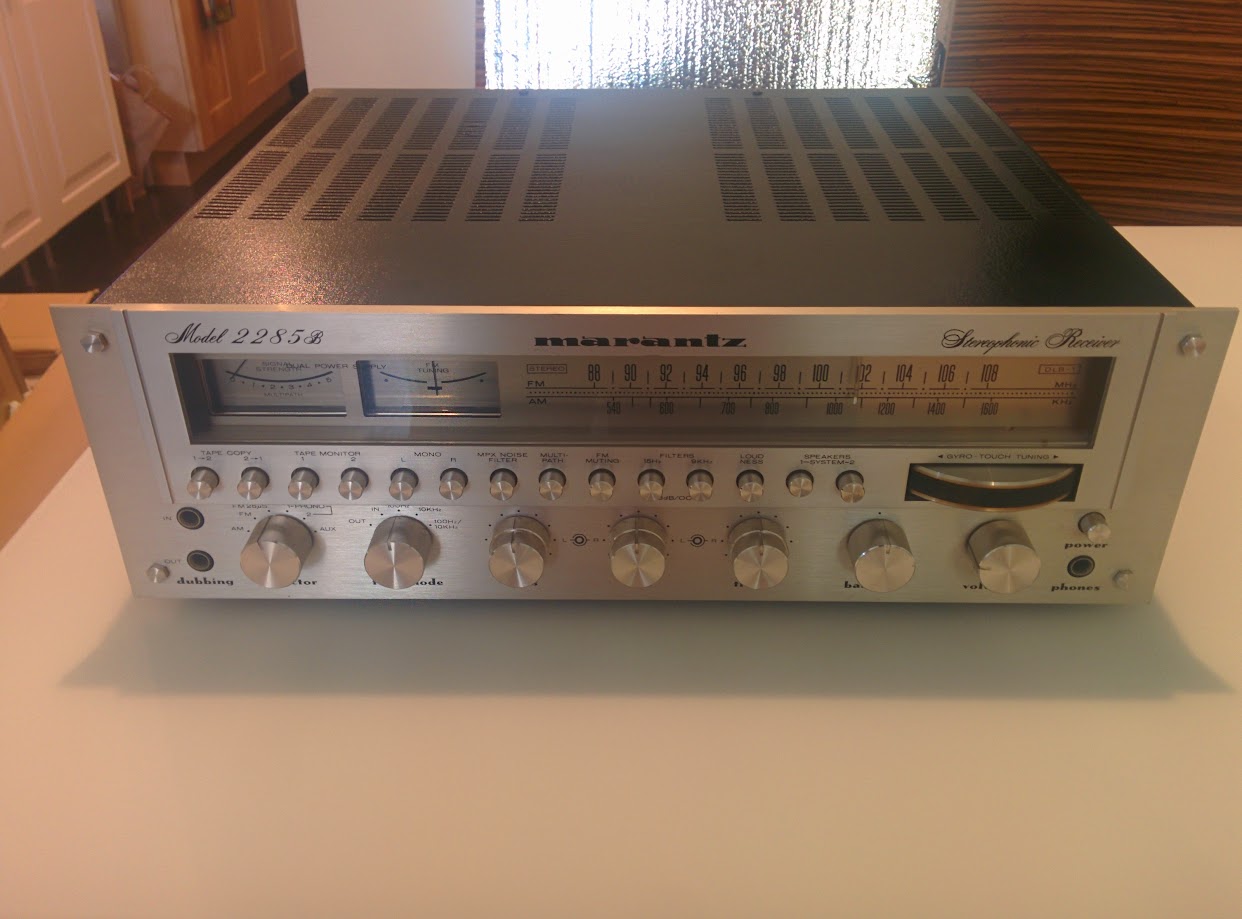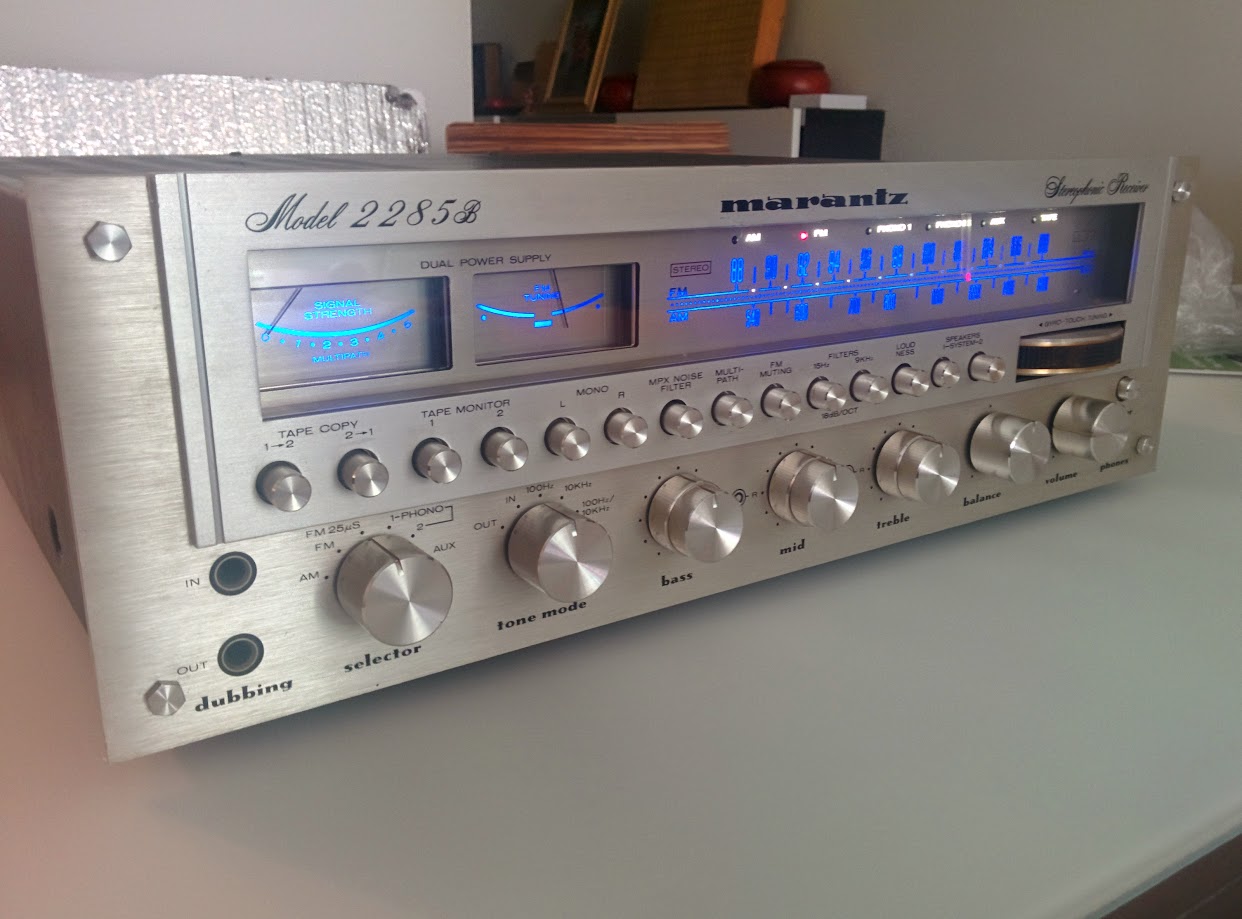The Marantz 2285B
|
For a while, I've occasionally noticed what sounds like a little bit of distortion coming from my left speaker. It's only slight and hardly noticeable,
my wife thinks I'm crazy. When I realized that it was actually there and intermittent, I started to hear it more and more, or sometimes I'm thinking I
hear it at least. I've gone through the speaker cable, re-cut the ends, cleaned the banana plugs, still there. I've opened up my Nakamichi receiver and
cleaned out the speaker connectors and also a few of the knobs which would generate some noise when I turn them, specifically the Balance knob. That
knob in particular had to be cleaned once before, when I noticed that my left channel was slightly quieter than the right and traced the problem down to
that knob. This time, cleaning it didn't make the distortion go away. I then further narrowed it down to only the Phono input. I don't hear the noise when
I play music through the computer. Immediately, I chocked it up to just my LP's being dirty or some of media related issue. But having a direct drive
turntable, I went back a few times to when I thought I heard distortion and wound back the LP and played the same bit over and over again and it was
still intermittent. I then took the turntable out of the equation when I plugged it directly into a small USB A/D converter and played several LPs, ripping them
into wav files, and playing it back through the computer, where I found there was no distortion. It wasn't the greatest of tests but it made me more
confident that it wasn't the Technics that was generating the distortion in the left channel. I also tried swapping the left and right RCA cables coming
out of the turntable and still heard the distortion on the left speaker. So the only things left is maybe the Phono pre-amp or some other
circuitry related to the Phono input. I could try buying a separate pre-amp and plugging that into another input, but I really don't have the room for another
component, or ultimately be wrong about the root cause and still have the distortion after buying a pre-amp, though there would probably be a better
sound coming out of my records.
So ultimately, I decided it was time to upgrade the receiver and say goodbye to the Nakamichi that has faithfully served me since college. There were a lot of options on the table. I wanted it to be an upgrade over the Nakamichi, I didn't need anything fancy like bluetooth or surround sound or anything, it didn't need to be A/V. It needed to have a Phono input, because I didn't want to buy a separate pre-amp, though buying a pre-amp was definitely on the table if I could find a good match up. After a bit more research, I've decided to go back to the 70's when top-of-the-line makers were doing everything in-house and designed every component, plus they had Phono inputs and general very well respected pre-amps for them. I wanted to stay under the $1000 mark or at least not incredibly past a grand so the real audiophile equipment was out of range. It dawned onto me that finding these old receivers in pristine condition was harder than I thought. I looked through forums, Ebay, and some trading sites but it seemed my best option was probably ebay, where at least the sellers had reviews and comments. Some of the receivers I looked for were the NAD 3020, Pioneer SX-1980 and the SX-1250, Rotel RS-1603, Kenwood KR-9050, and even a couple of Concept, Sansui, McIntosh, and Yamaha's. Working units were hard to find and a lot of entries on Ebay were for parts or listed as "untested". There were a few pretty nice looking Pioneer's but they were a bit too far north of $1000. Then I started looking through the 2200 series by Marantz. There was a lot of good press for the 2200's and many articles say that it was a "cut above the rest", and among some of the reviews and forum discussion, it sounded like the 2285B specifically was highly acclaimed. Another important aspect of the 2285B in particular was it can easily handle speakers between 4 to 8 ohms, and my Paradigms are 6 ohm speakers. Some people did note that the Marantz 2200 series did have some really nasty harmonic distortion at the very limits when it started clipping, whereas some of the other top-of-the-line receivers of the same price range dealt with the distortion a lot more calmly, like on the low end or 2nd/3rd order harmonics. But the 2285B has 85 RMS watts per channel, and there's no way I was going to be listening to anything at close to full volume. I saw a lot of nice looking 2270's and 2275's and there were two really nice 2285B's from 1978 that were fully restored and tested with LED upgrades for the old fuse lamps. I made some offers and ended up going with the one sold by Investment Audio from Oregon, they really sounded like they knew what they were doing with old receivers and even noted that the LED's they replaced the incandescent fuse lamps with were not random LED's soldered into the unit but were actually inside fuse housings so no damage had to be made to the sockets.

I'll be honest, a lot of people talked up the 2200 line of Marantz receivers about how great they look, but the tiny pictures on Ebay didn't wow me by any means. However, when I took it out of the box after it arrived (and by the way, it is really heavy, like 2 maybe 3 times heavier than the Nakamichi), it looked like a work of art. It was real solid, everything looked like polished/brushed aluminum, distinctive script labels, the "dual" knobs for each of the tone knobs, and probably the most memorable of all, the horizontal thumb controlled radio tuning wheel, the "Gyro Touch Tuning".

When I turned it on to give it a test whirl, the wonderful blue LED lighting glowed into life. It was glorious. Just like old receivers from the 70's and 80's, the tape inputs are its own separate loop (2 of them here) with an IN and OUT and in order to listen to the tape input, you have to select the monitor, which is a separate thing entirely from the input selector. Speaking of the input selector, you can also see that there is a 25 microsecond selection for the FM radio, which some people called Dolby FM, which used a pre-emphasis of the high frequencies before broadcast and then de-emphasizing them at the receiver. These days, that setting essentially makes the radio sound like crap because nobody broadcasts that way anymore. Another interesting thing is the signal meter for multipath. That goes together with the Multipath button next to the FM Muting. The idea is that when you tune FM/AM signals you want the direct signal vs ones that bounce around on buildings and things, i.e. the multipath signals. So when you tune to a station and pick it up, to fine tune even more, you press the Multipath button (which doesn't stay depressed) and check the signal meter to try to tune to the direct signal.

The back isn't anything remarkable. It's pretty clean and has an AM ferrite rod. The most interesting thing is probably the cartridge slot for the FM decoder, something that's antiquated like the 25 microsecond FM setting.


It also looks nice in the entertainment cabinet. I put the PS3 into the Tape 1 input since we don't use it very often, pretty much only when watching bluray's. Only other inputs I have is the computer (TV) and my turntable. The glow from the display also looks pretty nice through the tinted glass. So after hooking everything up, testing out the AM and FM tuning, playing around with the tone and various other buttons, it was time to put on some music and give it a real whirl:

Immediately, you notice how strong the bass response is. Not so much the bass in general, but like the really low frequencies, the ones that you really feel. It was so strong that I feared it would shake things in my neighbors' apartments. Don't get me wrong, it sounded awesome, but I wasn't sure if I wanted it to be that awesome. Fortunately, the Marantz 2285B has several Tone settings.
Overall, I'd say I'm really satisfied with my investment, and first foray into vintage amps and receivers, the 1978 Marantz looks great next to the 1979 Technics. It'll be a few weeks of listening to music and TV before I get a fuller idea of what the Marantz brings but I'm definitely looking forward to it. And the best thing of all? The distortion on the left channel is gone.
Filed under: Music
HOME,CONTACT, TWITTER, |